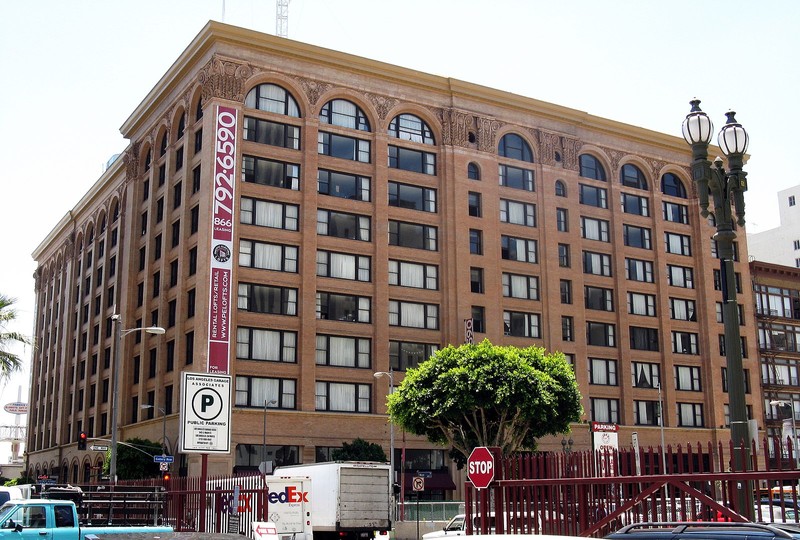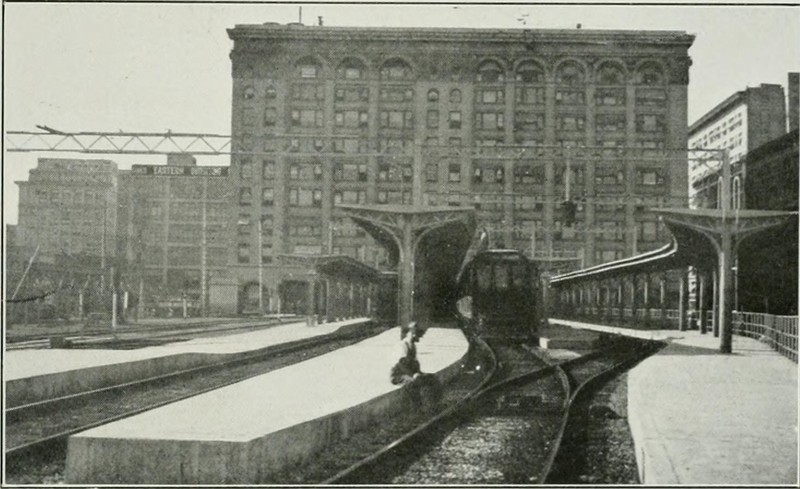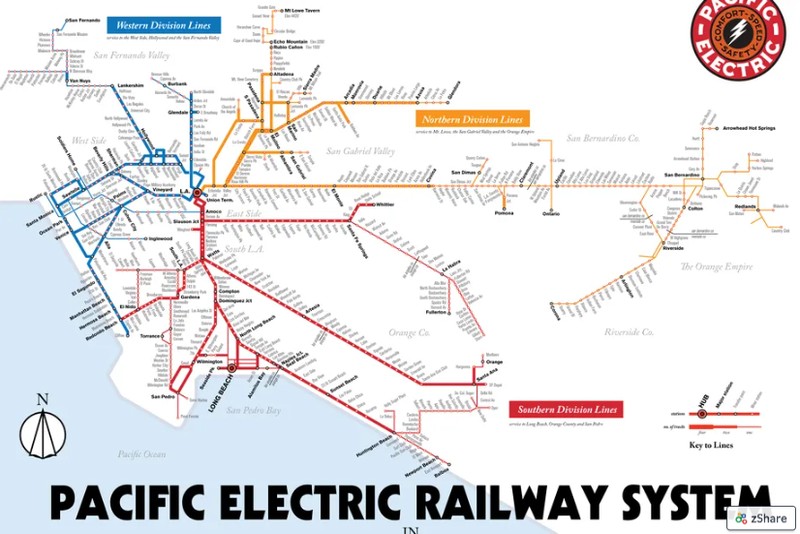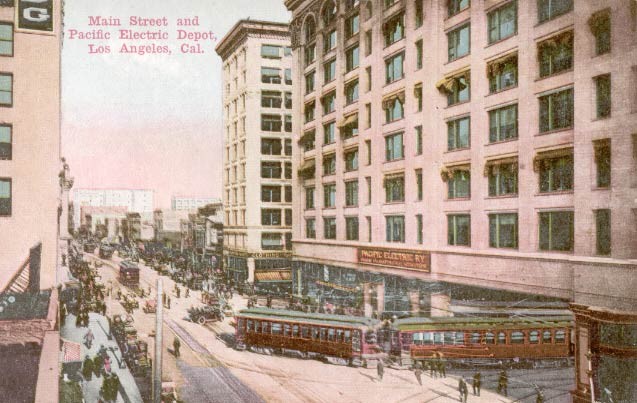Pacific Electric Building
Introduction
Text-to-speech Audio
The Pacific Electric Building opened in 1905 in the burgeoning center business district of Los Angeles. The building dually served as the Pacific Electric headquarters and as the company's main interurban streetcar train station. Known locally as the "Red Car" line, the network at is peak supported hundreds of cars running on tracks that spanned more than 1,000 miles throughout L.A. and surrounding areas. Before the city's famous freeway system emerged, its streetcar network defined the urban area and fostered the region’s early growth. When the ten-floor Pacific Electric Building opened, it encompassed the most square feet of an building west of Chicago for much of the first half of the twentieth century. Furthermore, the top three floors of the building was home to the Jonathan Club, a men's social club that still operates in L.A. today.
Images
Pacific Electric Building

Behind the Pacific Electric Building, tracks in the yard elevated above the street serve interurbans, c. 1920

Map shows LA’s Red Car system in its 1920s heyday

Postcard: View north on Main Street c. 1910, with the Pacific Electric Building at the right.

Pacific Electric Building c. 1905–1909
.jpg)
Backstory and Context
Text-to-speech Audio
Henry E. Huntington founded the Pacific Electric Railway Company in 1901, an interurban streetcar service for Los Angeles and its surrounding communities. (Pacific Electric did operate some freight trains, but it primarily acted as a passenger service.) Huntington ultimately desired to concurrently develop and sell land along the streetcar lines he generated. As part of his strategy, he bought and expanded an existing railway system that linked Pasadena and downtown Los Angeles.
A few years after founding Pacific Electric, he commissioned architects to build what would be L.A.'s first downtown skyscraper; it opened in January 1905. The building included popular turn-of-the-century Richardsonian Romanesque and Beaux Arts styles, popular nationally and in downtown Los Angeles during its first significant building boom during the first two decades of the twentieth century. Beaux Arts evolved into a trendy architectural style for the city's financial and commercial district buildings, notably in buildings exceeding ten stories.
Huntington sold the Pacific Electric line, and the building, to the Southern Pacific Railroad in 1910. By 1911, the merged company owned 415 cars, which were part of one, two, or three-car trains, all powered by an overhead electrified copper wire. At the company's peak, the streetcar line extended to more than 1,000 miles throughout Southern California. Most referred to the trains, made of wood and steel, as "Red Cars," because of the red and gold letters and trim (Huntington owned and operated a second line, the Los Angeles Railway Co., known as "Yellow Cars.")
The building additionally supported nearly 700 office spaces (ninety-five used by Pacific Electric) on floors two through seven and the Jonathan Club, a men's social club, on the top two floors. Republican supporters of William McKinley founded the Jonathan Club in 1894, and then it transitioned into a non-political club (officially) in 1895. When the club moved to the Pacific Electric Building in 1905, Huntington maintained a private suite in the club, and he served as its president. Like the vast majority of men's clubs found throughout the nation at that time, the club did not allow people of color and women to become members. (The club still exists in L.A., and it took until the 1960s for serious challenges to its white-men-only membership policies to emerge). The club remained in the building until it moved to its own facility in 1924. Members enjoyed the Jonathan Club's ballroom, theater, billiards room, card room, gymnasium, beer hall, dining hall, smoking room, library, and a large garden on the roof.
By the 1920s, the influx of automobiles on the roads, combined with both the Yellow Car and Red Car lines, led to congestion and delays. Thus, the city approved a measure to construct a subway system, which Pacific Electric built in 1925, along with a new subway station. But, the automobile's rising popularity ultimately led to the demise of the streetcar. By the 1930s, P.E. ridership significantly declined (also due to the Great Depression and increased unemployment rate), travel time increased, and revenues fell. On September 27, 1942, buses began using the depot of the Pacific Electric building. On January 1, 1950, the Pacific Electric Building was used for the last time for trains, with the rails removed in 1954.
Sources
Burns, Adam. "Pacific Electric Railway: 'Comfort, Speed, Safety'." American-Rails.com. October 1, 2022. https://www.american-rails.com/pacific.html.
McAvov, Christy and Jessica Ritz. "Registration Form: Pacific Electric Building." National Register of Historic Places. nps.gov. 2009. https://npgallery.nps.gov/GetAsset/2066ecac-b2da-44a2-aade-59d2351d1c7f.
"Pacific Electric: Hollywood Subway." The Electric Railway Historical Association of Southern California. erha.org. Accessed October 10, 2022. http://www.erha.org/pewhs.htm.
Wachs, Martin Wachs. "Autos, Transit, and the Sprawl of Los Angeles: The 1920s." Journal of the American Planning Association 50, no. 3 (1984): 297-310.
By Publichall - Own work, CC BY-SA 3.0, https://commons.wikimedia.org/w/index.php?curid=10682721
By California Public Utilities Commission - https://www.flickr.com/photos/internetarchivebookimages/tags/bookidrailroadgradecro00cali, Public Domain, https://commons.wikimedia.org/w/index.php?curid=88417994
Curbed Los Angeles: https://la.curbed.com/2018/9/6/17825186/los-angeles-streetcar-map-red-pacific-electric
By Unknown author - http://www.csulb.edu/~odinthor/MainPE.jpg, Public Domain, https://commons.wikimedia.org/w/index.php?curid=3794000
By Unknown author - http://digitallibrary.usc.edu/cdm/ref/collection/p15799coll65/id/6055, Public Domain, https://commons.wikimedia.org/w/index.php?curid=30862439
